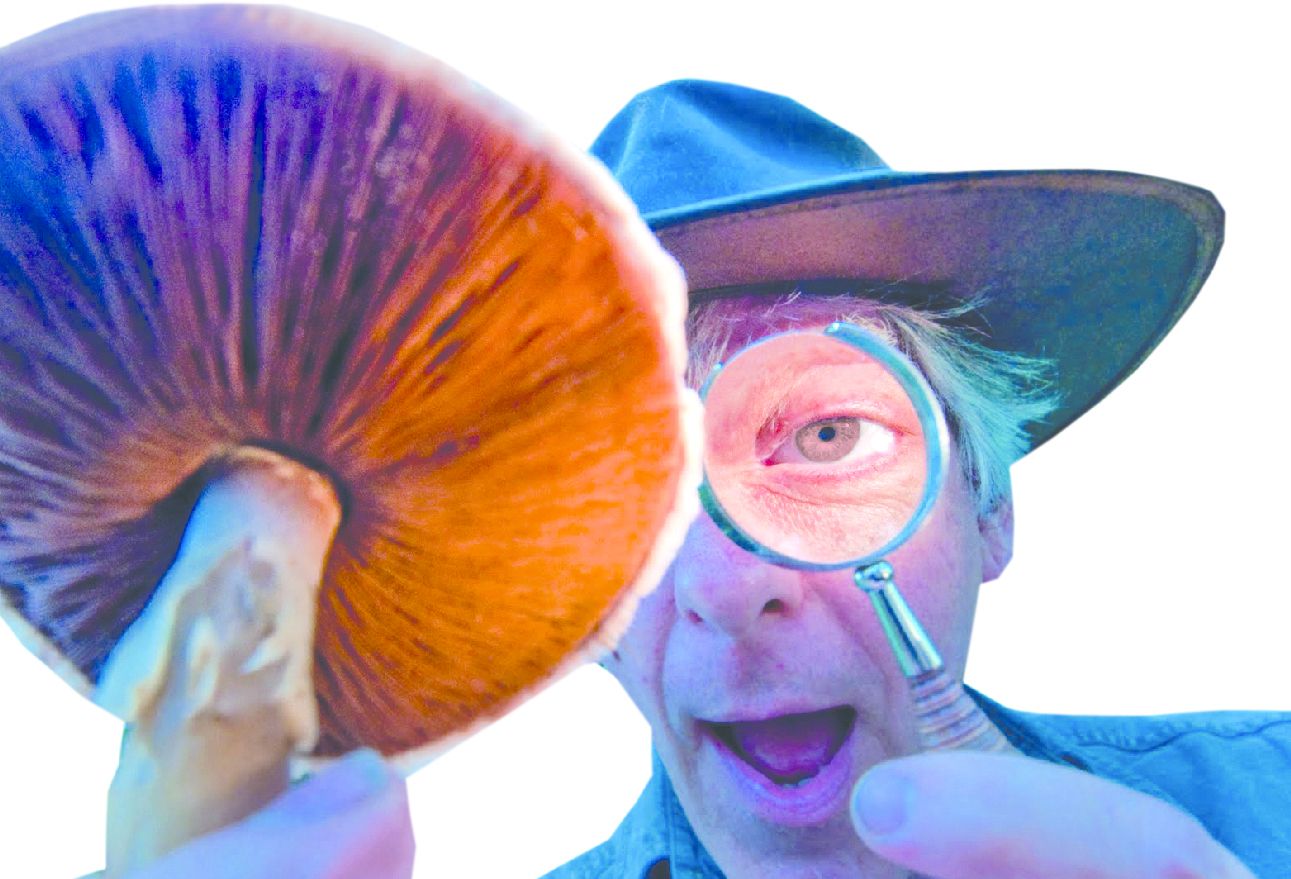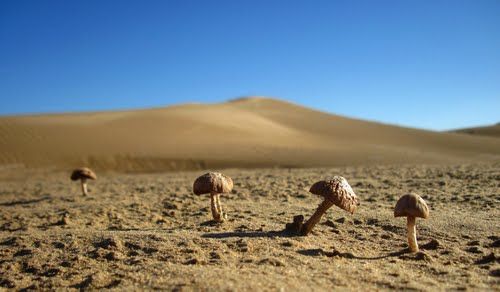
I tried mushrooms for the first time in my life when I was in the army. I served in the city of Leningrad (now St. Petersburg) in the military artillery academy named after M. Kalinin. The academy was located in the centre of the city on the coast of the Neva River. Once a month we used to go for training to a polygon - a shooting range. During the breaks between the sessions, the nurse who accompanied us, used to distribute to us, the young soldiers, whickered baskets and asked us to collect mushrooms in the woods nearby. In return she treated us with “soukhariki”- toasted sweet bread, which for us, in the fresh air, was sweeter than a slice of pie.
Being the son of the steppe, I knew nothing about mushrooms and collected them all, without knowing which ones were edible and which ones were poisonous. Afterwards, the nurse carefully sorted the edible ones and chucked away the poisonous.
By the way, champignons grew also on the territory of the academy, as well as in the flower-beds around it. Very often the city people used to come and collect them, but later when we discovered the taste of this delicacy, we politely asked them to avoid our territory.
After the boring taste of everyday soldier’s porridge which we jokingly called “kirzukha” or “kersey”*, the taste of fried mushrooms with onions and potatoes “elevated” us to the seventh heaven. I liked the taste of mushrooms so much, that later I took every chance to get them in any kind: pickled, marinated, dried, smoked, in brine, etc. In those days you couldn’t buy mushrooms neither in shops nor in green markets. Leave alone mushrooms; I tried ordinary eggplants for the first time in 1973 when I visited my Russian friend’s house. I then thought that there is no tastier food in the world than fried eggplants.
 Desert champignons
Desert champignonsTo my shame until I was 40 years old, I could not imagine that champignons grow here in Atyrau region. Once, when we were drilling wells in Kurmangazy region near the village of Ganyushkin, I travelled with some business issues to the neighboring drilling company - our colleagues from Volgograd who were drilling in the field next to us. When I arrived to their rotational camp, I saw bundles of dried mushrooms hanging between the wagon containers. The first idea that came to my head was that boys brought them all the way from Volgograd and hung them there to dry. When I was leaving, I asked them to give me some mushrooms. They treated me with one big bundle and told me that they collected them locally. It appeared that there were fields of mushrooms in the vicinity - within 2-3 kilometers. I immediately asked the driver to move in that direction. When we arrived, there was a beautiful meadow where cows were grazing and plantations of champignons were in abundance. Isn’t it nice that cows do not eat mushrooms! We did not have any containers or bags with us. So we just threw mushrooms right into the cabin of our Gas-53 truck. We collected approximately a sackful of mushrooms and moved to our drilling rig.
At the neighboring drilling rig there was an elderly Russian woman working as the cook and I asked her to fry the mushrooms. She said that she never heard that mushrooms grow in our area, though she was born here and lived in Atyrau all her life. Well, for the feast with mushrooms, we organized a bottle of spirits and mushroom tasting started!
I was the only person in the team who ever tried mushrooms. We had a drilling foreman called Bazarbai, who refused point blank even to try them. Maybe, he didn’t like the dark color of mushrooms, but others also were very apprehensive and careful at the beginning, but when they tried them, they started to enjoy the taste. I could even hear the “cracking” sounds of their jaws and ears (Joke). Bazarbai with interest was observing us, a crowd that shoveled down mushrooms with high speed. He could not hold himself anymore and decided to try. And instantly after the first spoonful, he snatched out the saucepan and clasping the saucepan with one hand, finished it with the table spoon till it was empty.
The years went by and I was seconded to work in Afghanistan in 1979 -1982. We, the Soviet expats, lived in a separate camp. The houses were hostel type buildings, where several families shared one common kitchen. We cooked our food there and also spent our leisure time, celebrated events and holidays. Once, our neighbor, the topography expert who, by the fate of his service, spends major part of this work in the fields, brought into our kitchen a package of champignons and started to wash them in the sink. Everybody, of course, rushed to him and showered him with questions: where he found them, asked him to share mushrooms, etc. We had expats from the western Ukraine, who are, traditionally, considered to be experts of mushrooms. To their questions there followed a cold answer from the hard-fisted neighbour: “There are not enough mushrooms even for myself.” And to the question where he found them, the answer came: “One needs-to-know where mushrooms grow.” And that’s it, he kept it as a secret.
We drilled at the foothills of Hindu Kush Mountains and to each well under pressure fresh water was pumped for various needs and Afgani shepherds who were passing by with their herds of sheep very often used to come to fill their leather bottles with water. Once when they again came for the water, I noticed that one shepherd took something from under his hem and started eating. I got curious and asked him what he was eating. It turned out that he was eating raw mushrooms, putting a bit of salt on them. At that moment you wouldn’t even need to persuade me, though I never tired raw mushrooms before. Boy, weren’t they yummy?! Without thinking twice I made a deal. In exchange for lollipop-sweets called “Barberry” that you could buy only in our Soviet camp shop, he would bring me mushrooms. When I arrived to work the next day with the paper cone full of Barberry sweets and at the appointed time the shepherd appeared with a lapful of mushrooms. I did not expect that he would collect so much, 5-6 kg of hand-picked, white, beautiful champignons. Both sides were happy about the deal and immediately we agreed to the next batch to be brought the next day.
When I appeared in the kitchen with the “riches” that I brought and poured out mushrooms into the sink, the neighbors lost their gifts for speech. They slowly uttered one sentence: “Where… have you… collected..?”, to what I jokingly answered: “One needs to know where mushrooms grow!” But I shared mushrooms with my neighbors and certainly treated our hard-fisted “khokhol.”**
The next day when I again appeared in the kitchen and poured out to the table even more mushrooms, my amazed neighbors stayed with their eyes wide open for some time. So, we used to arrange feasts with mushrooms in our kitchen until my contract ended. Even at the end of my contract I did not tell my secret about the place where mushrooms grow, leaving folks in amazement about the genius Kazakh mushroom picker.
In the middle of 1990-s our drilling company moved to Aktau and we were drilling in the Mangystau fields, where due to scorching sun the steppe doesn’t have enough time to cover itself with greens and fails to hold the beauty of spring steppe long enough, quickly burns out. But even during this short time champignons manage to burst out and bring a real pleasure to gourmets and allow us to taste all subtleties of this divine product!
by Masat Kabdesh-Uly
(Retired Drilling Engineer)
*Kirzoukha (kersey) – strong solder’s boots made of tarpaulin.
** Khokhol- means Ukrainian, a nickname used by the Russians. Dates back to 17th century, when Ukrainians wore locks of long hair left on tops of their shaved heads.
January 31 2013, 16:24

 Desert champignonsTo my shame until I was 40 years old, I could not imagine that champignons grow here in Atyrau region. Once, when we were drilling wells in Kurmangazy region near the village of Ganyushkin, I travelled with some business issues to the neighboring drilling company - our colleagues from Volgograd who were drilling in the field next to us. When I arrived to their rotational camp, I saw bundles of dried mushrooms hanging between the wagon containers. The first idea that came to my head was that boys brought them all the way from Volgograd and hung them there to dry. When I was leaving, I asked them to give me some mushrooms. They treated me with one big bundle and told me that they collected them locally. It appeared that there were fields of mushrooms in the vicinity - within 2-3 kilometers. I immediately asked the driver to move in that direction. When we arrived, there was a beautiful meadow where cows were grazing and plantations of champignons were in abundance. Isn’t it nice that cows do not eat mushrooms! We did not have any containers or bags with us. So we just threw mushrooms right into the cabin of our Gas-53 truck. We collected approximately a sackful of mushrooms and moved to our drilling rig.
Desert champignonsTo my shame until I was 40 years old, I could not imagine that champignons grow here in Atyrau region. Once, when we were drilling wells in Kurmangazy region near the village of Ganyushkin, I travelled with some business issues to the neighboring drilling company - our colleagues from Volgograd who were drilling in the field next to us. When I arrived to their rotational camp, I saw bundles of dried mushrooms hanging between the wagon containers. The first idea that came to my head was that boys brought them all the way from Volgograd and hung them there to dry. When I was leaving, I asked them to give me some mushrooms. They treated me with one big bundle and told me that they collected them locally. It appeared that there were fields of mushrooms in the vicinity - within 2-3 kilometers. I immediately asked the driver to move in that direction. When we arrived, there was a beautiful meadow where cows were grazing and plantations of champignons were in abundance. Isn’t it nice that cows do not eat mushrooms! We did not have any containers or bags with us. So we just threw mushrooms right into the cabin of our Gas-53 truck. We collected approximately a sackful of mushrooms and moved to our drilling rig.  В Атырау -9
В Атырау -9